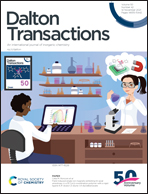Colorimetric detection of fluoride ions in aqueous medium using thiourea derivatives: a transition metal ion assisted approach†
Abstract
This work explores the position of the hydroxyl moiety and its participation in intramolecular H-bonding towards dictating the fluoride selective colorimetric response in functionalized thiourea derivatives. The study reveals the pivotal aspect of the hydroxyl moiety in C2 towards attaining selectivity for fluoride over acetate and dihydrogenphosphate ion. Furthermore, a methodology employing stabilization of deprotonated thiourea through metal ion (Ni2+ and Cu2+) coordination is proposed for the colorimetric sensing of fluoride in water medium. The mechanism of interaction is thoroughly studied by UV-Vis, 1H NMR, ESR spectroscopy, electrochemical techniques and further validated by DFT calculations. This study reveals the formation of an in situ Ni2+ complex that shows greater stability in aqueous medium. The methodology is applied in the detection of fluoride in groundwater samples.



 Please wait while we load your content...
Please wait while we load your content...